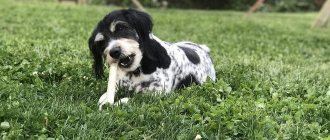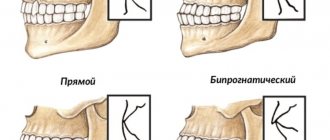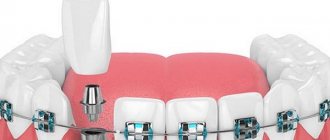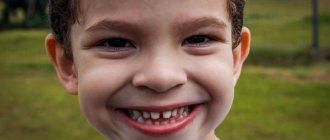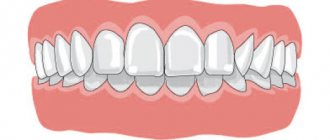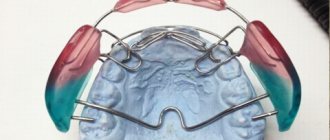Bite in dogs, the types of which can be different, is one of the points in assessing the animal. Unfortunately, the pet does not always meet the required standard due to incorrect positioning of the teeth. In such cases, it is better to consult a specialist - it is quite possible that everything can still be corrected. It is recommended to pay attention to the animal’s teeth and bite in order to detect the problem in time.
Correct bite is the basis for the health of your furry pet
Main types of bite
There are several types of bite patterns in dogs. They depend on the breed of the animal. Main varieties:
- scissor-shaped - is normal,
- pincer-shaped - the second name for straight,
- undershot,
- snacking is more common in bulldog-shaped dogs.
Depending on the dog's breed, the structure of the jaws, their length and development may vary.
However, sometimes a distortion in the structure of the facial bones is possible. Attention! A dog's bite is also affected by teeth - they can grow incorrectly, which is why various pathologies arise.
Scissor bite
Dogs have always been considered predatory animals. To survive, wild representatives have to constantly hunt. Their jaws are designed to grab and then hold prey. Therefore, a scissor bite is considered the most correct.
A similar structure is diagnosed in almost all dogs. Thanks to a scissor bite, teeth are less likely to wear down and the risk of disease is reduced. This jaw structure is typical for German shepherds, Labradors, terriers, Dobermans, Rottweilers, and Jagdterriers. Most breeds have a scissor bite.
According to the correct pattern, the front surface of the lower incisors quite tightly adjoins the back of the upper ones and abuts against their base. The fangs form a “lock”.
Correct positioning of teeth allows the dog to eat normally
Pincer bite
This type of bite is considered a problem and a defect for most dog breeds. However, it is not considered to be a very significant disadvantage.
In the pincer-shaped form, the upper and lower incisors rest against each other. As a result of this situation, they quickly wear down and the teeth become unusable. Fangs and molars are not affected.
The pincer-like arrangement of the jaws can be congenital or acquired.
Attention! This condition can occur when the puppy is played with a lot of tug games. As a result, the lower teeth may move forward.
Underbite
An underbite in a dog is considered a more serious fault. Often such dogs are simply removed from various competitions. With this pathology, underdevelopment of the lower jaw is noted. As a result, there remains free space between the incisors, and the lower canines do not fit tightly to the edges of the upper jaw.
Unfortunately, underbite in a puppy often causes the development of various diseases. The remaining teeth are subject to great pressure and frequent destruction. In addition, tartar quickly forms. Therefore, the question of what to do if a puppy has an underbite worries many owners.
The most common is a scissor bite.
Reviews of plates for teeth straightening
Looking through the reviews from parents, it can be noted that they are all positive. Children quickly get used to wearing the equipment. All dental defects are corrected quickly. It cannot be said that for all children the operation with the installation of plates is completely painless, but if everything is chosen correctly, the inconvenience quickly passes.
Dentists also respond well to the plates. Some believe that in adults, correcting defects with plates is even more convenient. For them, this is done even longer, once, but in children, as the jaw grows, the correction plates need to be changed.
Snack
Underbiting in dogs can occur if the pet has short jaws. In some breeds, such a structure is considered normal and is not considered a defect. These varieties include bulldogs, Pekingese and bull terriers - these are dogs with a forward jaw.
When overbiting, the lower incisors are in front of the upper ones, while the lower jaw is slightly pushed forward. Some teeth may even become exposed.
Attention! Basically, this arrangement is also defective. However, for Cane Corso dogs, for example, a hearty snack is considered normal.
What other defects are found?
Unfortunately, these are not the only jaw problems that are possible. There are other variants of pathologies.
You may encounter a problem such as jaw misalignment. In this case, it does not close smoothly and empty spaces form between the incisors. The condition often becomes the development of various diseases in the dog.
Another defect develops as a result of improper growth and placement of teeth. Sometimes the fangs may be located closer to the center, which will also affect the position of the jaws.
Removable plates
This is the “good old” classic of early orthodontic treatment. Many parents of my young patients talk about their experiences with plate therapy in childhood. Despite the long life of the plates, they do not lose their relevance, since they provide excellent treatment results, and in terms of cost they are one of the most budgetary options for orthodontic treatment.
The main component of the success of treatment is good cooperation, because the plate must be worn 24 hours a day (including school and night time). The disadvantages of the records include problems with diction and the child’s fatigue due to the duration of treatment (usually 1-1.5 years). To make the records, we use only high-quality imported materials; the child can choose any colors, sparkles and pictures so that the treatment takes place with great enthusiasm and pleasure.
Examples of excellent treatment results on plate
Before treatment
After treatment
Before treatment
After treatment
Why is the bite deformed?
There are several reasons for malocclusion. This phenomenon may be congenital, or it may become acquired over a period of time. Main reasons:
- Most often it is a genetic problem, which is why purebred dogs suffer, especially small breeds (Papillons, lapdogs, corgis). It is worth noting that puppies are carefully culled and are never used to breed dogs with jaw defects.
- Injuries can cause dental problems. Especially those that occur at a young age.
- Defects can develop due to a lack of nutrients and minerals. At the same time, the lack of such elements in a pregnant bitch will also have a negative impact on the puppy.
- Violent games, when there is a lot of stress on the jaw, can also provoke a problem in the future. As a result, a dog may grow up with teeth forward.
Attention! Malocclusion in pets can also be caused by poor nutrition and lack of nutrients, resulting in dental problems.
Incorrect positioning of teeth causes many problems for your pet.
TO SUM UP:
Summing up all the necessary stages, the minimum cost of correcting a bite using a simple metal brace system will be = 500 + 3,000 + 30,000 + 30,000 + (36,000 * 2 jaws) + 18,000 = 153,500 rubles.
Those. for two years of treatment you will spend the amount of 153,500 rubles.
If we divide this amount by 24 months (average treatment time), we find that the average financial burden for one month over two years will be 6,396 rubles.
To summarize, we can say that yes, the cost of braces varies greatly. However, no matter what brace system you choose, the result will exceed all your expectations, the treatment time in the positive environment of the ArtDental clinic will fly by quickly, and you will have a beautiful and happy smile!
How to prevent the development of defects
To prevent the development of defects in the animal, it is recommended to try to exclude all possible causes. Prevention is a correct and balanced diet, including all the necessary elements.
With a small puppy, you need to play tug games very carefully so as not to disturb the position of the teeth, otherwise you end up with a dog with a protruded jaw, which is very difficult to correct.
It is recommended to carefully examine the dog’s oral cavity from childhood, especially during the period of change in the primary bite. If problems arise, you need to consult a specialist - remove the baby tooth or correct the bite with the help of special devices (at a young age this is much easier to do).
Causes
The reasons why crossbite occurs are as follows:
- narrowing of the jaw;
- atypical position of tooth buds;
- early/late teething or change of milk teeth, loss of chewing units before term. Adjacent elements simply fill the free space;
- long-term bad habits (lip biting, thumb sucking, etc.);
- injuries, complications after surgical procedures;
- bone diseases can cause deep bite;
- mouth breathing. When you breathe through your mouth, the tongue goes down and does not put pressure on the upper jaw as it should, and the lips and cheeks continue to act in the opposite direction and, accordingly, the upper jaw arch narrows and deepens, a crossbite occurs;
- heredity, genetic predisposition;
- a birth defect, a pathology that occurs during pregnancy, or a birth injury.
You can often hear the statement that the pathology of the bite is influenced by the position of a person during sleep.
Consequences of malocclusion for a dog's health
An incorrect bite causes certain inconvenience to the dog, and the consequences of such a pathology can be completely sad:
- The inability to chew food normally leads to various pathologies of the gastrointestinal tract.
- Severe malocclusion may result in oral injury.
- When the jaws do not close tightly, there is a constant release of saliva, which can cause various skin diseases.
If deviations from the norm are mild, they rarely cause problems for the dog. However, in any case, it is better to go to the clinic. Even an uneven row of lower incisors in a dog can cause the development of pathologies.
Fixes
In some cases, your doctor may suggest trying to straighten your dog's bite. For this purpose, two types of devices are used:
- Removable devices
These are transparent aligners that are removed if necessary - while eating and brushing your teeth. The rest of the time the dog constantly stays in them.
The aligners constantly put pressure on the teeth, causing them to move into the required position. Must be replaced every few months.
For puppies, ring-braces made of hard rubber are offered; they exert a little less pressure.
- Fixed structures
Such devices are made of fairly dense material and are placed on the teeth, after which they are adjusted using a special wire and clasps. If necessary, you can adjust the pressure force.
There are various ways to correct an animal's bite.
What is better - braces or braces?
The plates are only effective for people under 15 years of age and may not help in some situations. And even at the age of 10-12 years, in some cases it is necessary to install braces. If the pathologies are minor and are in the initial stage, then it is enough to use plates.
Advantages:
- Possibility to remove if necessary;
- Easy to care for your oral cavity;
- Cheaper than braces.
Flaws:
- Often not effective enough;
- Long-term addiction.
Advantages of braces:
- Continuous action on teeth;
- Quick addiction;
- A larger number of defects can be eliminated simultaneously.
Flaws:
- Difficulties in caring for the oral cavity;
- High cost for the entire range of services.
Contraindications to orthodontic treatment
The use of special designs is not permitted in all cases. Contraindications for dogs with malocclusion are:
- periodontal disease,
- allergic reactions to the materials from which the systems are made,
- stomatitis,
- gingivitis,
- formations in the oral cavity.
If necessary, you can even install dentures, but there must be a doctor’s prescription.
An incorrect bite can cause many problems in a dog's life. To maintain your pet’s health, it is recommended to monitor the development of your pet’s teeth from early childhood and take the necessary measures in a timely manner. It is important to monitor the dog’s nutrition and hygiene and provide the dog with proper care.
Plates for teeth straightening
Orthodontic plates are often called “braces” or “plates on the teeth.” This device is used to treat children under 15 years of age. Made individually for each child. It is attached to the outer surface, the inner part and can partially cover the sky. Made from soft or medium hard plastic and metal. The child takes food without any discomfort. There is no need for any special care for the plates.
Purpose:
- abnormal development of the bones of the jaw arches (narrowness of the jaw bone or disruption of its shape);
- the need to adjust the position of one or more teeth;
- movement of individual teeth;
- the presence of gaps between teeth (three and diastemas);
- the need to correct the narrowing of the palate;
- activation or slowdown of the jaw growth process;
- consolidation of results after using other orthodontic systems;
- preventing crowding;
- prevention of relapses of malocclusion, etc.
There is no need for any special care of the plates
